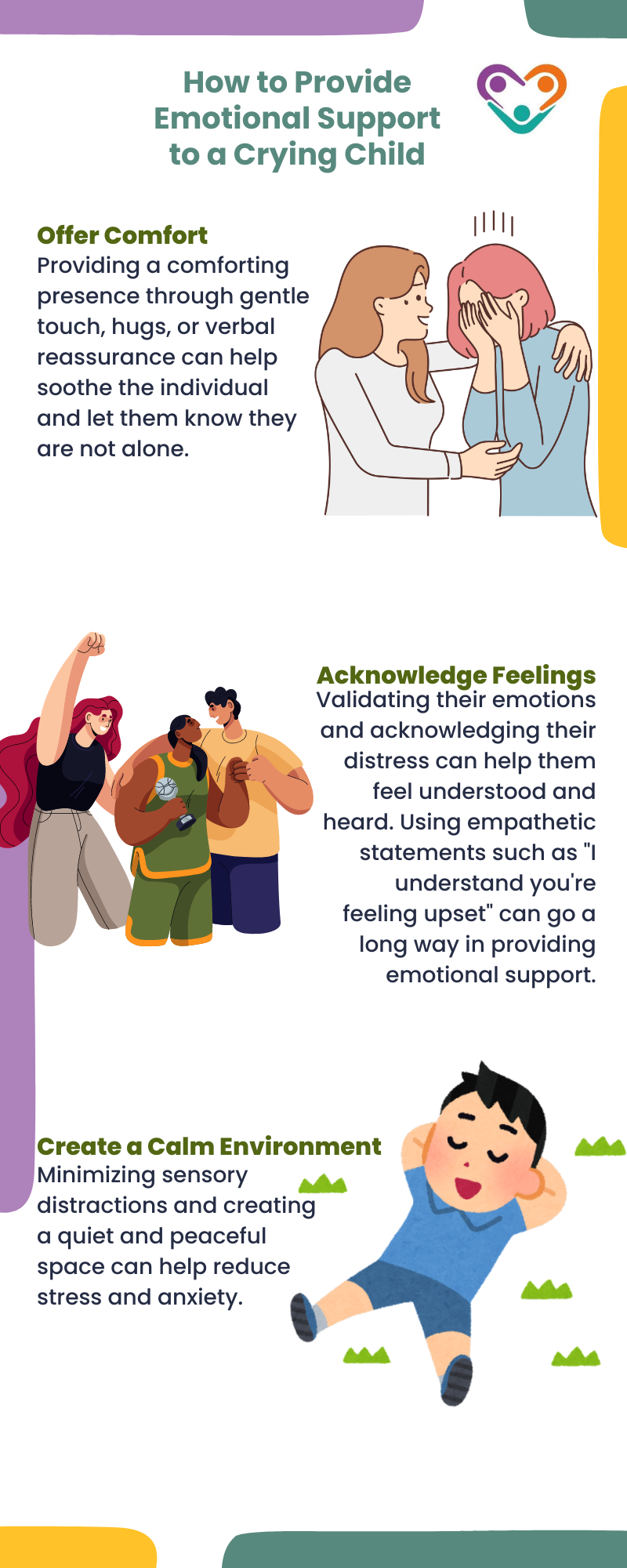When a child with autism cries seemingly for no reason, it can be challenging for parents and caregivers to understand the underlying causes. However, by delving into the unique characteristics of autism, we can gain insights into why crying episodes may occur.
Children with autism often face difficulties in fully conversational communication. As such, crying becomes a means of communication for them, especially when they are overwhelmed by demands and have limited ability to express their exact needs or feelings.
That said, it is essential to recognize that crying is a form of communication for these children, and it may indicate their frustration, discomfort, or a desire for attention.
Encouraging alternative methods of communication can be beneficial in reducing the reliance on crying as a means of expression. Visual aids, sign language, and communication apps are effective tools that can help neurodivergent children communicate their needs and feelings more effectively, potentially reducing their tendency to cry.

Behavioral Triggers for Crying
Crying episodes in children with autism may occur more frequently when there are high demands or low reinforcement. It is important to create an environment that encourages positive behavior and minimizes triggers for crying. This can be achieved by making reinforcement high and adjusting demands systematically to tackle problem behaviors.
Recognizing the triggers for autism crying is key to addressing the root causes. These triggers can vary from sensory overload to changes in routine or frustration with communication. Keeping a journal to track when and where crying episodes occur can help identify patterns and provide insights into the specific triggers affecting the child.
By understanding these triggers, parents of autistic children can take proactive steps to alleviate the factors leading to crying episodes.
Creating a calming environment tailored to the child’s sensory needs can significantly reduce autism crying episodes. This may involve adjusting lighting, reducing noise levels, and providing comforting textures. Additionally, maintaining a consistent routine can help the child feel more secure and reduce anxiety, which in turn can contribute to a decrease in crying episodes.

How to Address Autism Crying
Caring for a child with autism can present unique challenges, especially when it comes to understanding and addressing their crying episodes. Here are some strategies to help address and manage autism-related crying:
Preventing Problem Behaviors
Crying in children with autism may occur frequently when there are high demands or low reinforcement. One effective approach to prevent problem behaviors, including crying, is to make reinforcement high and demands low. By systematically adjusting these factors, parents and caregivers can create an environment that minimizes stress and frustration for their children.
It’s important to identify triggers that lead to crying episodes and modify the environment accordingly. This may involve breaking tasks into smaller, manageable steps, providing clear instructions, and offering positive reinforcement for each successful completion.
By focusing on positive reinforcement and reducing demands, parents and caregivers can help minimize the occurrence of crying episodes.
Creating a Calming Environment
Creating a calming environment tailored to the child’s sensory needs can significantly reduce autism crying episodes. Each child with autism has unique sensory sensitivities, so it’s essential to observe and understand their specific triggers and preferences.
Adjusting lighting, reducing noise levels, and providing comforting textures can help create a soothing atmosphere. Some children may find dimmed lights or natural lighting more calming, while others may prefer soft background music or white noise to drown out distracting sounds.
Offering sensory-friendly items like weighted blankets or fidget toys can also provide comfort and promote relaxation.
In addition to sensory modifications, maintaining a consistent routine can help the child feel more secure and reduce anxiety. Predictability and structure can be comforting for individuals with autism, reducing the likelihood of crying episodes. Establishing a daily schedule that includes predictable activities and transitions can provide a sense of stability and promote emotional well-being.
Encouraging Communication
For individuals with autism, communication difficulties can contribute to frustration and crying episodes. Encouraging alternative methods of communication can help neurodivergent children express their feelings and needs, potentially reducing their reliance on crying as a means of communication.
Visual aids, such as picture schedules or communication boards, can assist in conveying information and promoting understanding. Sign language or the use of communication apps specifically designed for individuals with autism can also facilitate effective communication.
Positive reinforcement for successful communication attempts can motivate and encourage the child to continue using these alternative methods.

Coping Strategies for Autism Crying
There are strategies that can help both the individual with autism and their caregivers cope with autism crying. These strategies are as follows:
Teaching Calming Techniques
One effective way to help individuals with autism manage their emotions and reduce crying episodes is by teaching them calming techniques. These techniques can vary depending on the individual’s preferences and needs. Some examples include the following:
- Deep breathing exercises– Encouraging slow, deep breaths can help regulate emotions and promote relaxation.
- Counting– Teaching the individual to count to 10 or use counting as a distraction technique can redirect their focus during distressing moments.
- Engaging in calming activities– Activities such as drawing, listening to soothing music, or engaging in sensory play can help redirect their attention and promote a sense of calm.
It’s important to introduce and practice these techniques during calm moments to help the individual become familiar with them. This way, they can utilize these strategies more effectively when faced with challenging situations.
Providing Emotional Support
Emotional support plays a crucial role in helping individuals with autism cope with crying episodes. Providing comfort, reassurance, and a calm presence can help them feel safe and supported. Some ways to provide emotional support include:

It’s important to note that crying releases oxytocin and endorphins, which can help individuals feel better and relieved. It’s crucial to avoid telling someone to stop crying, regardless of age or reason, as it can be a form of emotional abuse. Prolonged episodes of crying could also be signs of underlying mental health conditions or other health issues that may not be immediately apparent.
Seeking Professional Help
In some cases, prolonged episodes of crying in individuals with autism may indicate underlying mental health conditions or other health concerns that may not be immediately apparent. It is important for parents and caregivers to seek professional help if they are concerned about their child’s well-being.
Consulting with healthcare professionals who specialize in autism or mental health can provide valuable insights and guidance. They can help identify any underlying issues contributing to the crying episodes and develop appropriate strategies to address them.
Early intervention and support can significantly improve the emotional well-being of individuals with autism.
By understanding the reason behind crying in autistic children, parents and caregivers can play a vital role in promoting the emotional well-being of their kids. Creating a supportive and nurturing environment that embraces emotions and seeks to understand their unique needs can make a significant difference in their overall quality of life.
Sources:
https://marybarbera.com/autism-crying
https://getgoally.com/blog/autism-crying
https://childresidentialtreatment.com/autistic-child-always-crying



